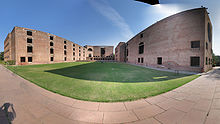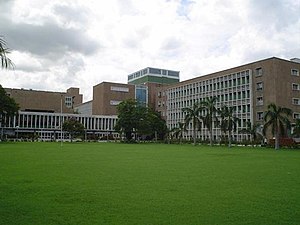Higher education
Main article: Higher education in India

The Auditorium at Indian Institute of Management Calcutta, Kolkata.
After passing the Higher Secondary Examination (the grade 12 examination), students may enroll in general degree programmes such as bachelor's degreein arts, commerce or science, or professional degree programs such as engineering, law or medicine.[38] India's higher education system is the third largest in the world, after China and the United States.[39] The main governing body at the tertiary level is the University Grants Commission (India), which enforces its standards, advises the government, and helps coordinate between the centre and the state.[40]Accreditation for higher learning is overseen by 12 autonomous institutions established by the University Grants Commission.[41] In India, education system is reformed. In the future, India will be one of the largest education hubs
As of 2012, India has 152[42] central universities, 316 state universities, and 191 private universities. Other institutions include 33,623[43] colleges, including 1,800 exclusive women's colleges, functioning under these universities and institutions,[40] and 12748 Institutions offering Diploma Courses. The emphasis in the tertiary level of education lies on science and technology.[44] Indian educational institutions by 2004 consisted of a large number of technology institutes.[45]Distance learning is also a feature of the Indian higher education system.[45] The Government has launched Rashtriya Uchchattar Shiksha Abhiyan to provide strategic funding to State higher and technical institutions. A total of 316 state public universities and 13,024 colleges will be covered under it.[46]
Some institutions of India, such as theIndian Institutes of Technology (IITs),Indian Institute of Science andUniversity of Mumbai have been globally acclaimed for their standard of undergraduate education in engineering.[45][47] The IITs enroll about 10,000 students annually and the alumni have contributed to both the growth of the private sector and the public sectors of India.[48] However the IIT's have not had significant impact on fundamental scientific research and innovation. Several other institutes of fundamental research such as the Indian Association for the Cultivation of Science (IACS),Indian Institute of Science (IISc), Tata Institute of Fundamental Research(TIFR), Harishchandra Research Institute (HRI), are acclaimed for their standard of research in basic sciences and mathematics. However, India has failed to produce world class universities both in the private sector or the public sector.[49]
Besides top rated universities which provide highly competitive world class education to their pupils, India is also home to many universities which have been founded with the sole objective of making easy money. Regulatory authorities like UGC and AICTE have been trying very hard to extirpate the menace of private universities which are running courses without any affiliation or recognition. Indian Government has failed to check on these education shops, which are run by big businessmen & politicians. Many private colleges and universities do not fulfill the required criterion by the Government and central bodies (UGC, AICTE, MCI, BCI etc.) and take students for a ride. For example, many institutions in India continue to run unaccredited courses as there is no legislation strong enough to ensure legal action against them. Quality assurance mechanism has failed to stop misrepresentations and malpractices in higher education. At the same time regulatory bodies have been accused of corruption, specifically in the case of deemed-universities.[50] In this context of lack of solid quality assurance mechanism, institutions need to step-up and set higher standards of self-regulation.[51]
The Government of India is aware of the plight of higher education sector and has been trying to bring reforms, however, 15 bills are still awaiting discussion and approval in the Parliament.[53] One of the most talked about bill is Foreign Universities Bill, which is supposed to facilitate entry of foreign universities to establish campuses in India. The bill is still under discussion and even if it gets passed, its feasibility and effectiveness is questionable as it misses the context, diversity and segment of international foreign institutions interested in India.[54]One of the approaches to make internationalization of Indian higher education effective is to develop a coherent and comprehensive policy which aims at infusing excellence, bringing institutional diversity and aids in capacity building.[55]

The American college in Madurai, started in 1881 CE – One of the first 5 colleges in India to get autonomous status
Three Indian universities were listed in the Times Higher Education list of the world's top 200 universities — Indian Institutes of Technology, Indian Institutes of Management, andJawaharlal Nehru University in 2005 and 2006.[56] Six Indian Institutes of Technology and the Birla Institute of Technology and Science – Pilani were listed among the top 20 science and technology schools in Asia byAsiaweek.[57] The Indian School of Business situated in Hyderabad was ranked number 12 in global MBA rankings by the Financial Times of London in 2010[58] while the All India Institute of Medical Sciences has been recognized as a global leader in medical research and treatment.[59] TheUniversity of Mumbai was ranked 41 among the Top 50 Engineering Schools of the world by America's news broadcasting firm Business Insider in 2012 and was the only university in the list from the five emerging BRICS nations viz Brazil, Russia, India, Chinaand South Africa.[60] It was ranked at 62 in the QS BRICS University rankings for 2013[61] and was India's 3rd best Multi Disciplinary University in the QS University ranking of Indian Universities after University of Calcutta and Delhi University.[62]




No comments:
Post a Comment